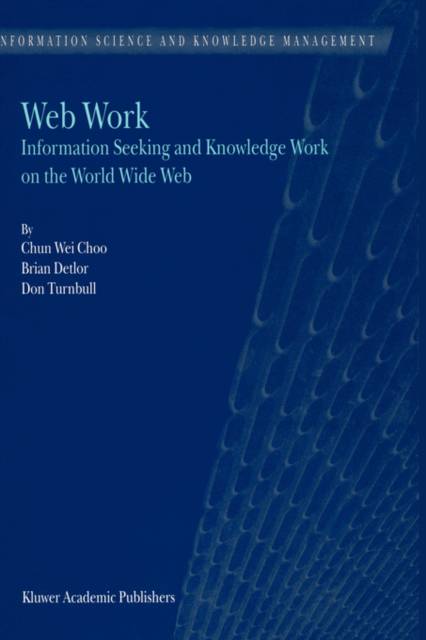
- Afhalen na 1 uur in een winkel met voorraad
- Gratis thuislevering in België vanaf € 30
- Ruim aanbod met 7 miljoen producten
- Afhalen na 1 uur in een winkel met voorraad
- Gratis thuislevering in België vanaf € 30
- Ruim aanbod met 7 miljoen producten
Zoeken
Web Work
Information Seeking and Knowledge Work on the World Wide Web
Chun Wei Choo, B Detlor, D Turnbull
€ 167,95
+ 335 punten
Omschrijving
This book brings together three great motifs of the network society: the seeking and using of information by individuals and groups; the creation and application of knowledge in organizations; and the fundamental transformation of these activities as they are enacted on the Internet and the World Wide Web. Of the three, the study of how individuals and groups seek information probably has the longest history, beginning with the early "information needs and uses" studies soon after the Second World War. The study of organizations as knowledge-based social systems is much more recent, and really gained momentum only within the last decade or so. The study of the World Wide Web as information and communication media is younger still, but has generated tremendous excitement, partly because it has the potential to reconfigure the ways in which people seek information and use knowledge, and partly because it offers new methods of analyzing and measuring how in fact such information and knowledge work gets done. As research endeavors, these streams overlap and share conceptual constructs, perspectives, and methods of analysis. Although these overlaps and shared concerns are sometimes apparent in the published research, there have been few attempts to connect these ideas explicitly and identify cross-disciplinary themes. This book is an attempt to fill this void. The three authors of this book possess contrasting backgrounds and thus adopt complementary vantage points to observe information seeking and knowledge work.
Specificaties
Betrokkenen
- Auteur(s):
- Uitgeverij:
Inhoud
- Aantal bladzijden:
- 219
- Taal:
- Engels
- Reeks:
- Reeksnummer:
- nr. 1
Eigenschappen
- Productcode (EAN):
- 9780792364603
- Verschijningsdatum:
- 31/08/2000
- Uitvoering:
- Hardcover
- Formaat:
- Genaaid
- Afmetingen:
- 165 mm x 246 mm
- Gewicht:
- 512 g

Alleen bij Standaard Boekhandel
+ 335 punten op je klantenkaart van Standaard Boekhandel
Beoordelingen
We publiceren alleen reviews die voldoen aan de voorwaarden voor reviews. Bekijk onze voorwaarden voor reviews.











